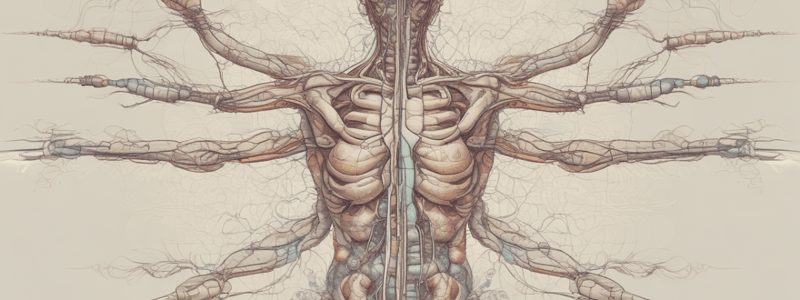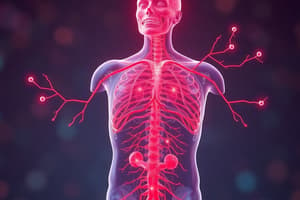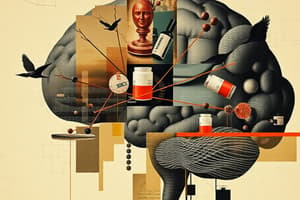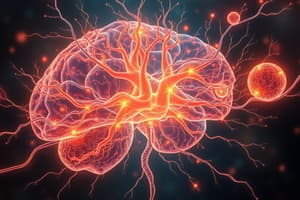Podcast
Questions and Answers
Which type of fibers uses acetylcholine as a neurotransmitter?
Which type of fibers uses acetylcholine as a neurotransmitter?
- Preganglionic fibers terminating in the adrenal medulla
- Postganglionic fibers of the sympathetic division
- Somatic motor neurons
- All of the above (correct)
What is the function of choline acetyltransferase?
What is the function of choline acetyltransferase?
- Transport of choline into the cytoplasm
- Storage of acetylcholine in vesicles
- Degradation of acetylcholine
- Catalysis of the reaction to form acetylcholine (correct)
What is the role of voltage-sensitive calcium channels in the release of acetylcholine?
What is the role of voltage-sensitive calcium channels in the release of acetylcholine?
- To increase the concentration of intracellular calcium (correct)
- To open the voltage-sensitive sodium channels
- To synthesize acetylcholine
- To decrease the concentration of intracellular calcium
What is the primary neurotransmitter stored in synaptic vesicles?
What is the primary neurotransmitter stored in synaptic vesicles?
What is the function of hemicholinium?
What is the function of hemicholinium?
What is the sequence of events in neurotransmission at cholinergic neurons?
What is the sequence of events in neurotransmission at cholinergic neurons?
What is the cotransmitter stored in synaptic vesicles along with acetylcholine?
What is the cotransmitter stored in synaptic vesicles along with acetylcholine?
What is the function of voltage-sensitive sodium channels?
What is the function of voltage-sensitive sodium channels?
What is the purpose of recycling choline and acetate?
What is the purpose of recycling choline and acetate?
Which division of the autonomic nervous system uses acetylcholine as a neurotransmitter?
Which division of the autonomic nervous system uses acetylcholine as a neurotransmitter?
What is the effect of botulinum toxin on the release of acetylcholine from synaptic vesicles?
What is the effect of botulinum toxin on the release of acetylcholine from synaptic vesicles?
Which receptors are G protein–coupled receptors?
Which receptors are G protein–coupled receptors?
What is the effect of acetylcholinesterase on acetylcholine in the synaptic cleft?
What is the effect of acetylcholinesterase on acetylcholine in the synaptic cleft?
Which subtype of muscarinic receptors is found on gastric parietal cells?
Which subtype of muscarinic receptors is found on gastric parietal cells?
What is the effect of nicotine on nicotinic receptors at high concentrations?
What is the effect of nicotine on nicotinic receptors at high concentrations?
Where are nicotinic receptors found in the nervous system?
Where are nicotinic receptors found in the nervous system?
What is the effect of direct-acting cholinergic agonists?
What is the effect of direct-acting cholinergic agonists?
Which subtype of muscarinic receptors is found on cardiac cells and smooth muscle?
Which subtype of muscarinic receptors is found on cardiac cells and smooth muscle?
What is the effect of activation of M1 or M3 receptors?
What is the effect of activation of M1 or M3 receptors?
What is the effect of nicotinic receptors on the effector cell?
What is the effect of nicotinic receptors on the effector cell?
What is the reason why acetylcholine has no therapeutic importance?
What is the reason why acetylcholine has no therapeutic importance?
What is the mechanism of action of acetylcholine in decreasing blood pressure?
What is the mechanism of action of acetylcholine in decreasing blood pressure?
What is the action of bethanechol on the detrusor muscle of the bladder?
What is the action of bethanechol on the detrusor muscle of the bladder?
What is the therapeutic use of bethanechol?
What is the therapeutic use of bethanechol?
What is the effect of pilocarpine on the eye?
What is the effect of pilocarpine on the eye?
What is the mechanism of action of pilocarpine in glaucoma?
What is the mechanism of action of pilocarpine in glaucoma?
What is the adverse effect of pilocarpine?
What is the adverse effect of pilocarpine?
What is the action of anticholinesterase agents?
What is the action of anticholinesterase agents?
What is the effect of atropine on the muscarinic receptors?
What is the effect of atropine on the muscarinic receptors?
What is the common use of atropine?
What is the common use of atropine?
What is the primary difference between edrophonium and physostigmine in terms of their duration of action?
What is the primary difference between edrophonium and physostigmine in terms of their duration of action?
What is the primary use of neostigmine in the management of myasthenia gravis?
What is the primary use of neostigmine in the management of myasthenia gravis?
What is the primary adverse effect of tacrine, donepezil, rivastigmine, and galantamine?
What is the primary adverse effect of tacrine, donepezil, rivastigmine, and galantamine?
What is the mechanism of action of echothiophate?
What is the mechanism of action of echothiophate?
What is the therapeutic use of a topical ophthalmic solution of echothiophate?
What is the therapeutic use of a topical ophthalmic solution of echothiophate?
What is the primary difference between reversible and irreversible AChE inhibitors?
What is the primary difference between reversible and irreversible AChE inhibitors?
What is the antidote for edrophonium-induced cholinergic crisis?
What is the antidote for edrophonium-induced cholinergic crisis?
What is the primary use of pyridostigmine?
What is the primary use of pyridostigmine?
What is the primary source of toxicity for irreversible AChE inhibitors?
What is the primary source of toxicity for irreversible AChE inhibitors?
What is the primary difference between edrophonium and neostigmine in terms of their therapeutic uses?
What is the primary difference between edrophonium and neostigmine in terms of their therapeutic uses?
What is the primary mechanism of action of botulinum toxin?
What is the primary mechanism of action of botulinum toxin?
What is the function of phospholipase C in muscarinic receptor signaling?
What is the function of phospholipase C in muscarinic receptor signaling?
What is the primary difference between muscarinic and nicotinic receptors?
What is the primary difference between muscarinic and nicotinic receptors?
What is the effect of butyrylcholinesterase on acetylcholine?
What is the effect of butyrylcholinesterase on acetylcholine?
What is the primary mechanism of action of M2 receptors?
What is the primary mechanism of action of M2 receptors?
What is the effect of choline uptake on synaptic transmission?
What is the effect of choline uptake on synaptic transmission?
What is the primary difference between M1 and M3 receptors?
What is the primary difference between M1 and M3 receptors?
What is the effect of nicotine on nicotinic receptors?
What is the effect of nicotine on nicotinic receptors?
What is the primary mechanism of action of direct-acting cholinergic agonists?
What is the primary mechanism of action of direct-acting cholinergic agonists?
What is the effect of acetylcholinesterase on acetylcholine?
What is the effect of acetylcholinesterase on acetylcholine?
Which anticholinesterase agent is used for the diagnosis of myasthenia gravis?
Which anticholinesterase agent is used for the diagnosis of myasthenia gravis?
What is the primary difference between edrophonium and physostigmine?
What is the primary difference between edrophonium and physostigmine?
What is the antidote for edrophonium-induced cholinergic crisis?
What is the antidote for edrophonium-induced cholinergic crisis?
Which anticholinesterase agent is used in the treatment of overdoses of anticholinergic drugs?
Which anticholinesterase agent is used in the treatment of overdoses of anticholinergic drugs?
What is the primary use of neostigmine?
What is the primary use of neostigmine?
What is the primary adverse effect of tacrine, donepezil, rivastigmine, and galantamine?
What is the primary adverse effect of tacrine, donepezil, rivastigmine, and galantamine?
What is the mechanism of action of echothiophate?
What is the mechanism of action of echothiophate?
What is the therapeutic use of a topical ophthalmic solution of echothiophate?
What is the therapeutic use of a topical ophthalmic solution of echothiophate?
What is the primary source of toxicity for irreversible AChE inhibitors?
What is the primary source of toxicity for irreversible AChE inhibitors?
What is the primary use of pyridostigmine?
What is the primary use of pyridostigmine?
What is the primary mechanism of ACh degradation?
What is the primary mechanism of ACh degradation?
Which of the following is NOT a component of the mature synaptic vesicle?
Which of the following is NOT a component of the mature synaptic vesicle?
What is the role of sodium in the uptake of choline by the cholinergic neuron?
What is the role of sodium in the uptake of choline by the cholinergic neuron?
Which of the following receptors is NOT stimulated by norepinephrine or epinephrine?
Which of the following receptors is NOT stimulated by norepinephrine or epinephrine?
What is the effect of inhibiting choline uptake on the synthesis of acetylcholine?
What is the effect of inhibiting choline uptake on the synthesis of acetylcholine?
What is the primary mechanism by which acetylcholine decreases blood pressure?
What is the primary mechanism by which acetylcholine decreases blood pressure?
Which of the following steps is NOT part of the neurotransmission process at cholinergic neurons?
Which of the following steps is NOT part of the neurotransmission process at cholinergic neurons?
Which of the following has a strong muscarinic activity and no nicotinic action?
Which of the following has a strong muscarinic activity and no nicotinic action?
What is the primary function of voltage-sensitive calcium channels in the release of acetylcholine?
What is the primary function of voltage-sensitive calcium channels in the release of acetylcholine?
What is the primary therapeutic use of pilocarpine?
What is the primary therapeutic use of pilocarpine?
What is the primary mechanism of action of hemicholinium?
What is the primary mechanism of action of hemicholinium?
What is the effect of indirect-acting cholinergic agonists on acetylcholine?
What is the effect of indirect-acting cholinergic agonists on acetylcholine?
Which of the following is a postganglionic fiber that uses acetylcholine as a neurotransmitter?
Which of the following is a postganglionic fiber that uses acetylcholine as a neurotransmitter?
What is the primary function of the cholinergic neuron in the autonomic nervous system?
What is the primary function of the cholinergic neuron in the autonomic nervous system?
What is the adverse effect of bethanechol that can be treated with atropine sulfate?
What is the adverse effect of bethanechol that can be treated with atropine sulfate?
What is the mechanism of action of pilocarpine in the eye?
What is the mechanism of action of pilocarpine in the eye?
What is the duration of action of bethanechol?
What is the duration of action of bethanechol?
What is the therapeutic use of bethanechol in the gastrointestinal tract?
What is the therapeutic use of bethanechol in the gastrointestinal tract?
What is the effect of acetylcholine on the heart rate?
What is the effect of acetylcholine on the heart rate?
What is the therapeutic use of atropine in relation to pilocarpine?
What is the therapeutic use of atropine in relation to pilocarpine?
Study Notes
Cholinergic Neurons
- Cholinergic neurons use acetylcholine (ACh) as a neurotransmitter
- Found in:
- Preganglionic fibers terminating in the adrenal medulla
- Autonomic ganglia (both parasympathetic and sympathetic)
- Postganglionic fibers of the parasympathetic division
- Postganglionic sympathetic division of sweat glands
- Muscles of the somatic system
Neurotransmission in Cholinergic Neurons
- 6 sequential steps:
- Synthesis
- Storage
- Release
- Binding of ACh to a receptor
- Degradation of the neurotransmitter
- Recycling of choline and acetate
Synthesis of Acetylcholine
- Choline is transported into the cytoplasm of the cholinergic neuron by cotransport with sodium
- Choline acetyltransferase catalyzes the reaction of choline with acetyl-CoA to form ACh
Storage of Acetylcholine
- ACh is stored in presynaptic vesicles by an active transport process
- Mature vesicles contain ACh, ATP, and proteoglycan
Release of Acetylcholine
- When an action potential reaches the nerve ending, voltage-sensitive calcium channels open, causing an increase in intracellular calcium
- Elevated calcium levels promote the fusion of synaptic vesicles with the cell membrane and the release of their contents into the synaptic space
Binding to the Receptor
- ACh released from the synaptic vesicles diffuses across the synaptic space and binds to postsynaptic receptors on the target cell
- Postsynaptic cholinergic receptors are divided into two classes: muscarinic and nicotinic
- Binding to a receptor leads to a biologic response mediated by second messenger molecules
Degradation of Acetylcholine
- ACh is rapidly terminated by acetylcholinesterase (AChE) that cleaves ACh to choline and acetate in the synaptic cleft
- Butyrylcholinesterase (pseudocholinesterase) is found in the plasma but does not terminate the effect of ACh in the synapse
Recycling of Choline
- Choline may be recaptured by a sodium-coupled transporter that transports the molecule back into the neuron
Cholinergic Receptors
- Two families of cholinoceptors: muscarinic and nicotinic receptors
Muscarinic Receptors
- G protein–coupled receptors (metabotropic receptors)
- Bind ACh and muscarine, but show only a weak affinity for nicotine
- Five subclasses of muscarinic receptors: M1, M2, M3, M4, and M5
- Mechanisms of acetylcholine signal transduction:
- M1 and M3 receptors: activation leads to production of second messengers (IP3 and DAG)
- M2 receptors: activation leads to inhibition of adenylyl cyclase and increase in K+ conductance
Nicotinic Receptors
- Ligand-gated ion channels
- Bind ACh and nicotine, but show only a weak affinity for muscarine
- Found in:
- CNS
- Adrenal medulla
- Autonomic ganglia
- Neuromuscular junction (NMJ) in skeletal muscles
Direct-Acting Cholinergic Agonists
- Mimic the effects of ACh by binding directly to cholinoceptors (muscarinic or nicotinic)
- Examples:
- Acetylcholine
- Bethanechol
- Pilocarpine
Indirect-Acting Cholinergic Agonists (Anticholinesterase Agents)
- Inhibit AChE, allowing ACh to accumulate in the synaptic space
- Examples:
- Edrophonium
- Physostigmine
- Neostigmine
- Pyridostigmine
- Tacrine, donepezil, rivastigmine, and galantamine
- Echothiophate (irreversible AChE inhibitor)
Cholinergic Neurons
- Cholinergic neurons use acetylcholine (ACh) as a neurotransmitter
- Found in:
- Preganglionic fibers terminating in the adrenal medulla
- Autonomic ganglia (both parasympathetic and sympathetic)
- Postganglionic fibers of the parasympathetic division
- Postganglionic sympathetic division of sweat glands
- Muscles of the somatic system
Neurotransmission in Cholinergic Neurons
- 6 sequential steps:
- Synthesis
- Storage
- Release
- Binding of ACh to a receptor
- Degradation of the neurotransmitter
- Recycling of choline and acetate
Synthesis of Acetylcholine
- Choline is transported into the cytoplasm of the cholinergic neuron by cotransport with sodium
- Choline acetyltransferase catalyzes the reaction of choline with acetyl-CoA to form ACh
Storage of Acetylcholine
- ACh is stored in presynaptic vesicles by an active transport process
- Mature vesicles contain ACh, ATP, and proteoglycan
Release of Acetylcholine
- When an action potential reaches the nerve ending, voltage-sensitive calcium channels open, causing an increase in intracellular calcium
- Elevated calcium levels promote the fusion of synaptic vesicles with the cell membrane and the release of their contents into the synaptic space
Binding to the Receptor
- ACh released from the synaptic vesicles diffuses across the synaptic space and binds to postsynaptic receptors on the target cell
- Postsynaptic cholinergic receptors are divided into two classes: muscarinic and nicotinic
- Binding to a receptor leads to a biologic response mediated by second messenger molecules
Degradation of Acetylcholine
- ACh is rapidly terminated by acetylcholinesterase (AChE) that cleaves ACh to choline and acetate in the synaptic cleft
- Butyrylcholinesterase (pseudocholinesterase) is found in the plasma but does not terminate the effect of ACh in the synapse
Recycling of Choline
- Choline may be recaptured by a sodium-coupled transporter that transports the molecule back into the neuron
Cholinergic Receptors
- Two families of cholinoceptors: muscarinic and nicotinic receptors
Muscarinic Receptors
- G protein–coupled receptors (metabotropic receptors)
- Bind ACh and muscarine, but show only a weak affinity for nicotine
- Five subclasses of muscarinic receptors: M1, M2, M3, M4, and M5
- Mechanisms of acetylcholine signal transduction:
- M1 and M3 receptors: activation leads to production of second messengers (IP3 and DAG)
- M2 receptors: activation leads to inhibition of adenylyl cyclase and increase in K+ conductance
Nicotinic Receptors
- Ligand-gated ion channels
- Bind ACh and nicotine, but show only a weak affinity for muscarine
- Found in:
- CNS
- Adrenal medulla
- Autonomic ganglia
- Neuromuscular junction (NMJ) in skeletal muscles
Direct-Acting Cholinergic Agonists
- Mimic the effects of ACh by binding directly to cholinoceptors (muscarinic or nicotinic)
- Examples:
- Acetylcholine
- Bethanechol
- Pilocarpine
Indirect-Acting Cholinergic Agonists (Anticholinesterase Agents)
- Inhibit AChE, allowing ACh to accumulate in the synaptic space
- Examples:
- Edrophonium
- Physostigmine
- Neostigmine
- Pyridostigmine
- Tacrine, donepezil, rivastigmine, and galantamine
- Echothiophate (irreversible AChE inhibitor)
Studying That Suits You
Use AI to generate personalized quizzes and flashcards to suit your learning preferences.
Description
Understanding the classification of drugs affecting the Autonomic Nervous System, including cholinergic and adrenergic drugs and their actions on receptors. This includes the role of acetylcholine, norepinephrine, and epinephrine.




